User-generated content (UGC), which refers to content created by users, has recently become a powerful tool for building brand awareness and driving engagement.
However, today’s UGC statistics show that its impact goes beyond just engagement—UGC also plays a big role in boosting conversion rates.
That said, people can tell when UGC feels too much like a sales pitch. The key is to use UGC based on real customer experiences while aligning it with your marketing goals.
This article will guide you through the most important user-generated content stats and how to use them strategically.

What is User-Generated Content (UGC)?
Whether you’re familiar with the term or not, let’s break it down.
User-generated content is any kind of content—images, videos, text, or audio—created by users. While it’s usually shared on social media, it can also appear on review sites, forums, and other platforms.
Instead of the brand doing all the promotion, consumers or employees create content on behalf of the company, sharing their experiences with the products, services, or even the company culture.
UGC was traditionally a focus for B2C companies, where fans and customers shared their love for the brand’s products or services.
But in recent years, B2B companies have also embraced UGC, especially in the form of employee-generated content.
Content created by employees has proven to be a very powerful way to extend a brand’s reach and influence.
General User-Generated Content Stats
In today’s fast-changing world, people are seeking authenticity more than ever. Since now everyone has access to a huge online community, they can easily share their thoughts, and there’s no turning back.
Before trying a product or service, users tend to trust the experiences of other customers. We’re sharing a list of user-generated content stats by highlighting some of the most important ones first:
1. Consumers find UGC nearly 10 times more influential than influencer content when deciding what to buy.
2. Millennials, aged 25 and up, are the main creators of UGC, making up over 70% of all content.
3. According to Keywords Everywhere, searches related to UGC are high, showing that both brands and individuals are keen to make the most of it.
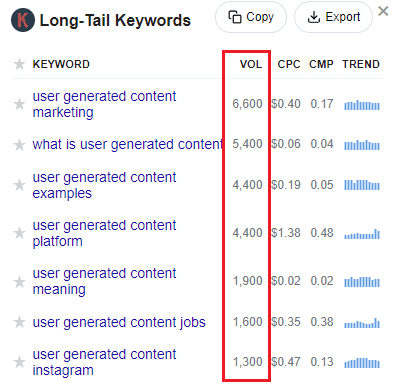
4. ComScore found that brand engagement jumps by 28% when people see a mix of professional marketing and user-generated content.
5. In a Statista survey, U.S. consumers said their top two social media activities were sending private messages and liking or following others. Posting pictures, videos, or updates came in fourth.
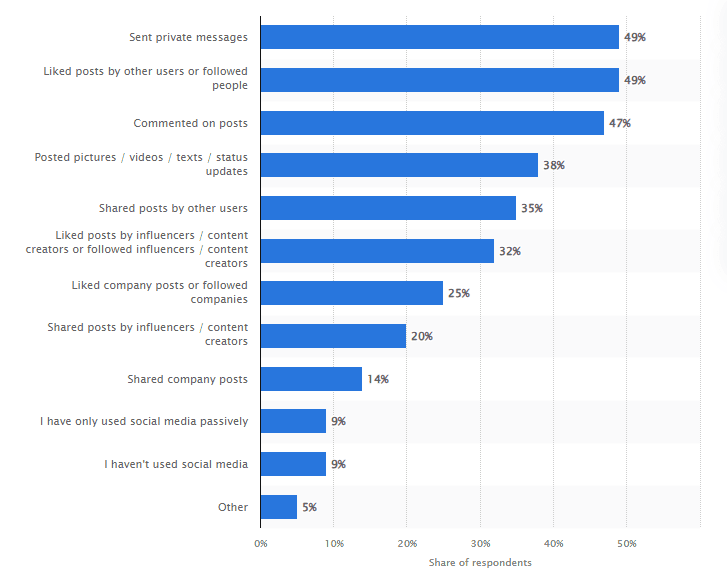
Source
6. A huge 70% of shoppers check UGC reviews or ratings before buying something, with 41% reading four to seven reviews to get a better understanding of the product.
7. 93% of marketers who use UGC say it outperforms traditional branded content by a significant margin.
8. About 40% of shoppers say UGC is “extremely” or “very” important when deciding what to buy—more than product comparison charts (39%) or product videos (37%).
9. Consumers are most convinced by high-quality reviews (21%), average star ratings (19%), and the number of reviews (13%) when making a purchase.
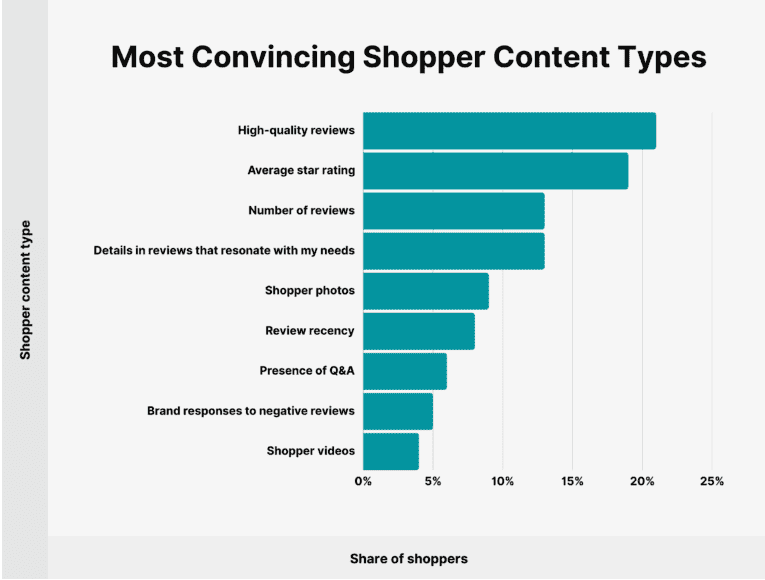
Source
Impact of UGC on Purchase Decisions
Major brands are now mixing user-generated videos and images with their traditional ads, moving away from solely relying on traditional advertising. This shift helps brands stand out as industry leaders by focusing on authentic marketing.
All of this shows that UGC strongly influences people’s buying decisions, although its impact is beginning to decline.
Here are some key user-generated content stats that show how it can influence purchase decisions.
10. About 82% of consumers say they’re more likely to buy from a brand that includes user-generated content (UGC) in its marketing.
11. Among shoppers surveyed, 13% would cancel their online purchase if there’s no UGC available.
12. When deciding to buy, shoppers find reviews (78%), Q&As (77%), and photos shared by other people (69%) to be the most helpful types of UGC.
13. According to Nielsen’s Global Trust in Advertising report, 92% of people worldwide trust recommendations from family and friends more than other types of advertising. Online reviews stand as the second most trusted source for brand information.

Source
14. Real content created by everyday people strongly influences buying choices across all age groups, with 79% saying it impacts them and 93% finding it very useful.
15. Importantly, 82% of people have bought or thought about buying something after seeing it posted by their friends or connections.
16. About 56% of shoppers are more likely to shop for a product after seeing it in a relatable or positive UGC photo.
17. A significant 70% of shoppers look at UGC reviews or ratings before making a purchase, with many reading four to seven reviews to inform their decision.
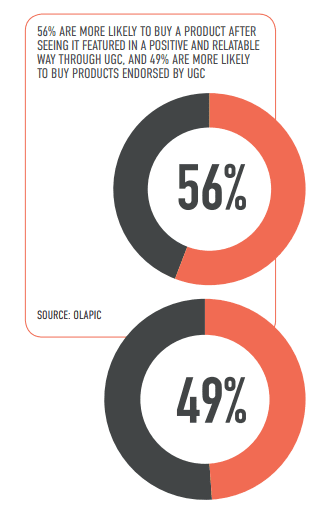
Source
UGC and Building Brand Trust
UGC is not just a random occurrence; you can actually promote and use user-generated content by integrating and repurposing it in your marketing strategy. Here are some important user-generated content stats that show how much users trust brands that use it:
18. 84% of Millennials trust brands more when they include content from real customers in their digital marketing campaigns.
19. The numbers change for older generations: 52% of Baby Boomers and 45% of the Silent Generation trust UGC.
20. Trust in UGC varies by region. In Europe, 74% of customers find UGC more trustworthy than branded content.
21. Women are generally more likely to trust UGC than men, but there’s no difference in trust for gender-neutral products like laptops.
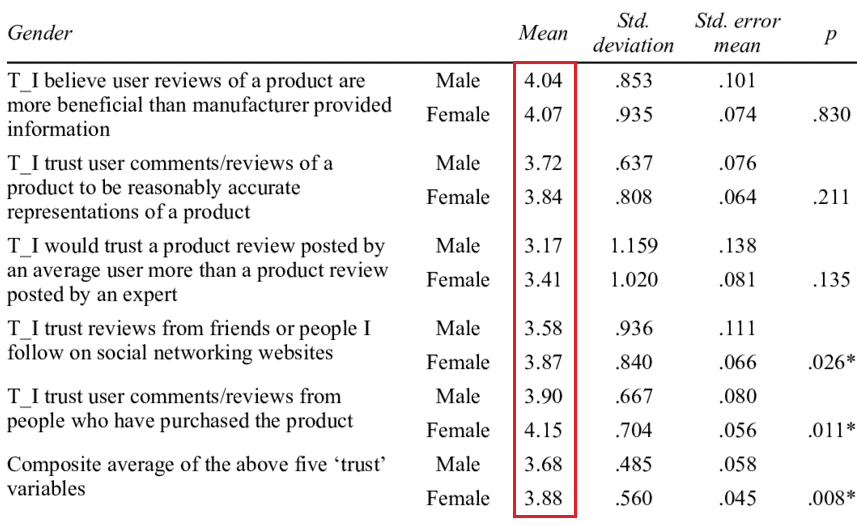
Source
22. TikTok users are 58% more likely to trust user-generated content on the platform compared to other social media sites.
23. A significant 92% of consumers trust word of mouth and UGC more than traditional brand advertising.
24. About 60% of people think content created by customers is the most authentic, while only 20% feel that brand-created content is somewhat authentic.
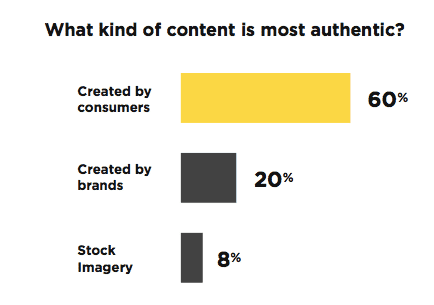
Source
25. Using UGC can also help destination marketing organizations (DMOs) build trust. Nearly 65% of people aged 18 to 44 would be more loyal to a brand that asks for and uses their content in marketing campaigns.
UGC in Marketing Strategies
Even though user-generated content is such a powerful marketing tool, only a few marketing professionals use it. And even fewer have clear guidelines for their campaigns despite the fact that their target audience wants those guidelines.
Another big issue is that while UGC can greatly influence buying decisions, brands mainly use it for engagement rather than boosting conversion rates.
Below, we’ve shared some user-generated content stats that highlight what marketers think about UGC.
26. 85% of marketers say that visual user-generated content (UGC) is seen as a more cost-effective choice compared to traditional professional photography or influencer content.
27. A large majority, 81% of e-commerce marketers, agree that visual UGC is more effective at reaching customers than professionally taken photos or influencer content.
28. Almost one-third, or 28% of e-commerce marketers, think Instagram is the best platform for engaging user-generated content, more than any other social media site.

Source
29. When it comes to the kinds of visual content that generate the most trust among customers, UGC ranks first at 33%, followed by professionally shot content at 24% and influencer-generated content at 18%.
30. 60% of marketers report that their audience engages more with UGC in marketing channels compared to branded content.
31. Adding UGC helps make a brand seem more authentic, and 75% of marketers believe this strategy works.
32. The growth of UGC is prompting travel marketers to let creators share their stories about destinations. A remarkable 98% of marketers, regardless of budget, share creator-made content through Instagram ads.
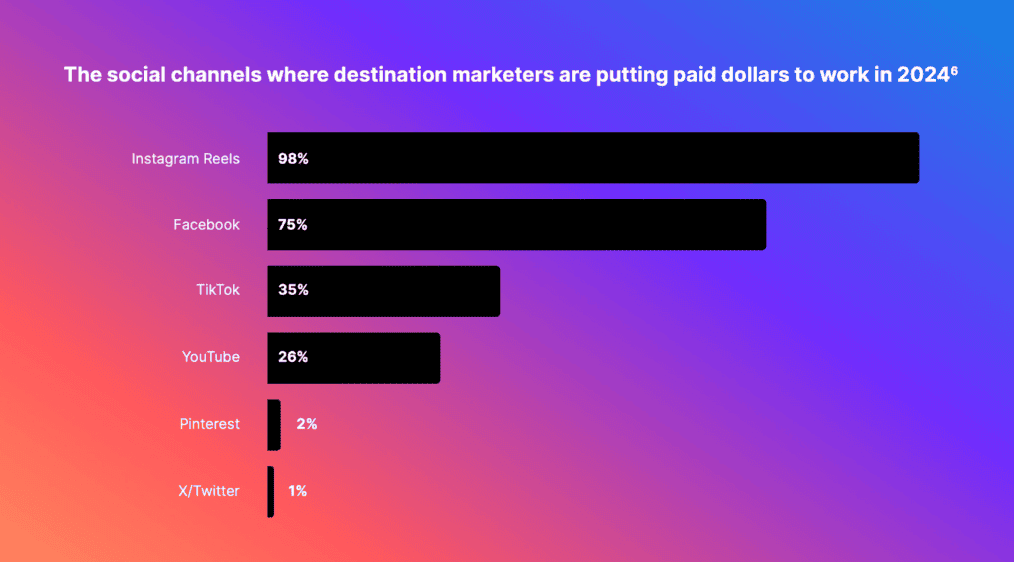
Source
33. Over 50% of marketers think that user-generated videos provide a better return on investment than professionally produced videos.
34. Three out of four marketers believe UGC is crucial for building brand trust in today’s tech-driven world.
35. 72% of marketers have shifted at least 20% of their budget toward UGC strategies.
UGC’s Effect on Engagement Rates
UGC is more engaging than content created by brands, but you need to use the right strategy. When people share great content about their favorite brands on social media, it boosts engagement.
This engagement rate is 8 times higher when employees post content compared to regular users. Now, let’s take a look at some user-generated content stats:
36. Brands that use UGC have a 28% higher engagement rate than those that don’t.
37. By the end of 2023, brands incorporating UGC into their marketing will see a 25% increase in engagement.
38. Social media campaigns with UGC boost engagement by 50%, and blogs featuring UGC also experience a 50% jump in engagement.
39. Instagram posts that include UGC get 70% more engagement than posts without it.
40. Customers are almost three times more likely to engage with a brand’s social media than with any other type of content.
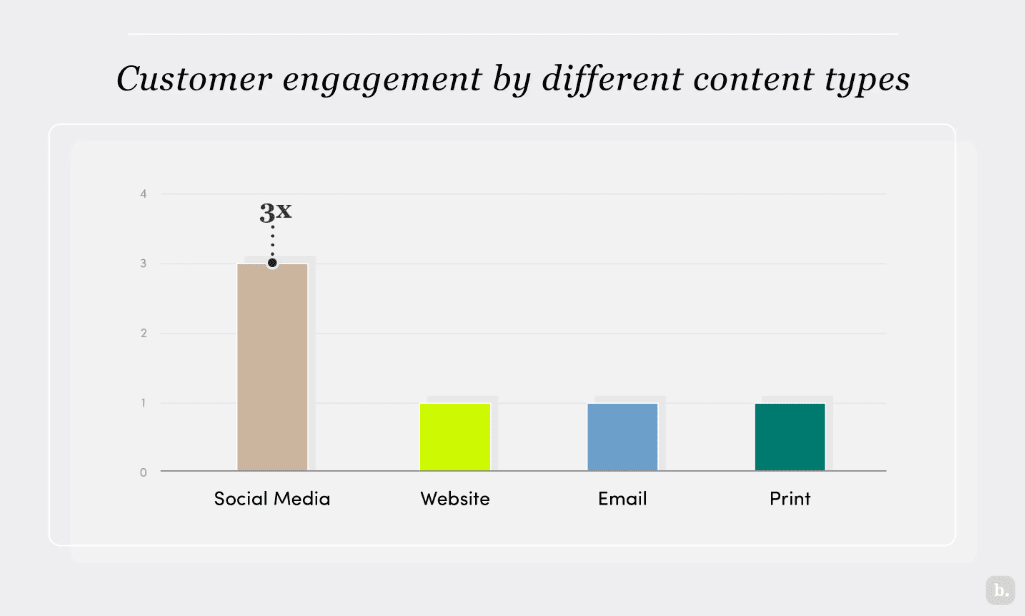
Source
41. Social media posts featuring user-generated content see a 28% higher engagement rate when compared to regular brand posts.
42. Combining professional content with UGC increases brand engagement by 28%.
43. Content shared by employees gets 2x as much engagement as content shared by brand accounts.
44. Customers are excited to engage in conversations with brands and want to be noticed. 72% of users are willing to share their content when asked by a brand.
45. When influencers create content about products, that’s considered UGC. Micro-influencers get 7 times more engagement than mega-influencers on Instagram.
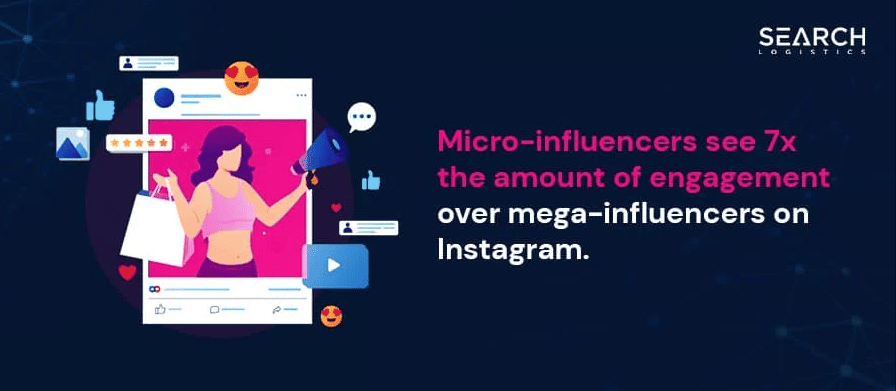
Source
UGC and Social Media
People dislike content that feels overly salesy or self-promotional. However, user-generated content (UGC) performs well on social media. It’s not just UGC—many potential clients appreciate authentic brand content as well.
Here are some important user-generated content stats on social media:
46. 45% of users would unfollow a brand if they feel it promotes itself too much on social media.
47. 74% of consumers use social media to help them make buying decisions.
48. 58.6% of consumers are more likely to interact with user-generated content on social media. Among them, 15.2% engage with videos, while 9.4% engage through newsletters.
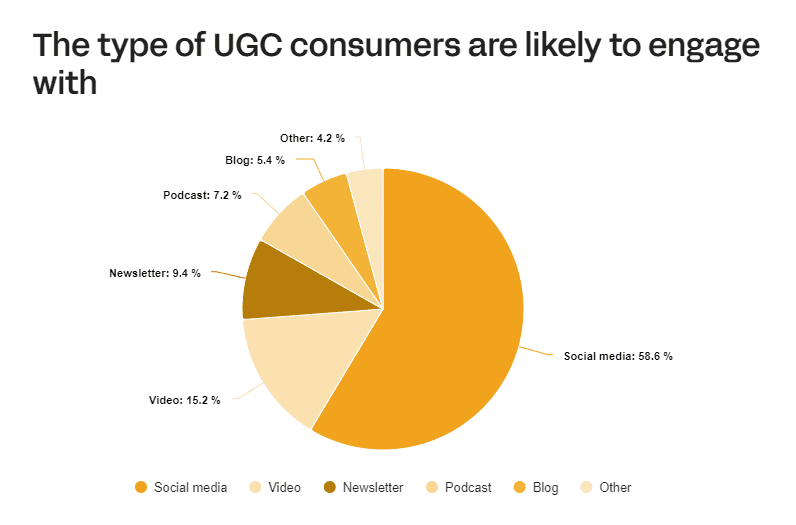
Source
49. 98% of employees are active on at least one social media platform for personal use, and 50% of them share posts about their company.
50. User-generated content is so powerful that 32-39% of millennials won’t book a hotel or travel experience with a brand that doesn’t use it in their online marketing.
51. Social media campaigns that have user-generated content (UGC) see a 25% boost in performance.
52. 34% of consumers find “too much self-promotion” a major turn-off when they see brands on social media.
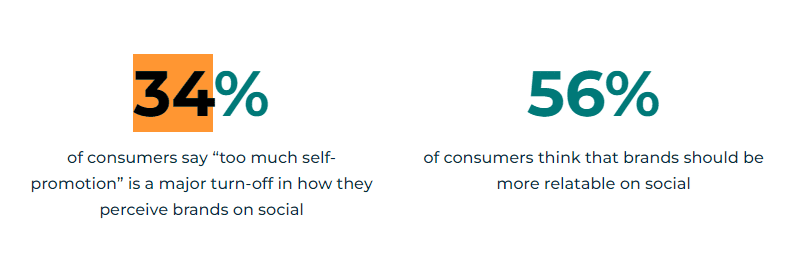
Source
53. 42% of shoppers are willing to buy a product even if it only has user-generated photos and no professional ones.
54. 41% of brands and retailers share social content from fans and influencers with their shop floor staff to connect with shoppers.
55. Companies experience 50% higher engagement when they use user-generated content in their social media campaigns.
UGC and Its Appeal to Millennials and Gen Z
The younger generation is really enthusiastic about user-generated content. They find it memorable when brands share this type of content, and they’re also eager to create it themselves.
Here are some user-generated content stats that highlight its appeal across different generations:
56. Millennials are very active in creating and consuming UGC, with this group generating 70% of it.
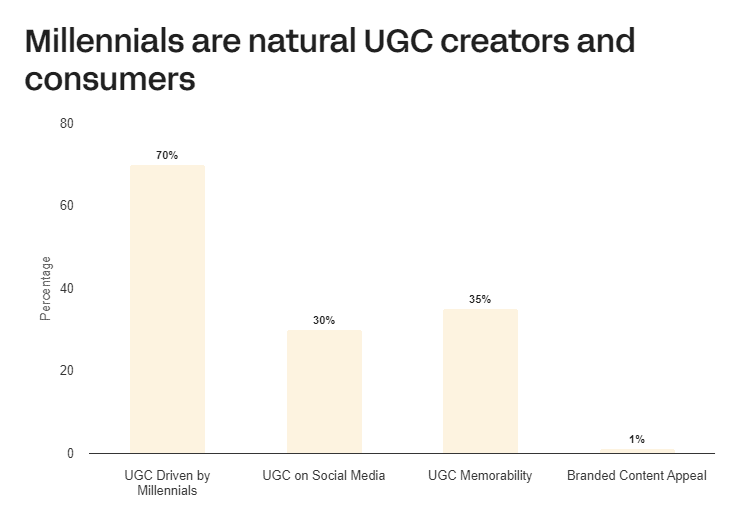
Source
57. They find UGC 35% more memorable than content from traditional sources.
58. Millennials trust UGC 50% more than original content made by brands.
59. On average, millennials spend 18 hours a day with media, and 30% of that time is spent on user-generated content.
60. UGC significantly influences millennial spending; it’s 20% more effective than other media types when they make purchases. For example, 59% of millennials use UGC for guidance on electronics, 54% for cars, 53% for major appliances, 46% for mobile phones, 45% for hotel choices, and 40% for travel plans.
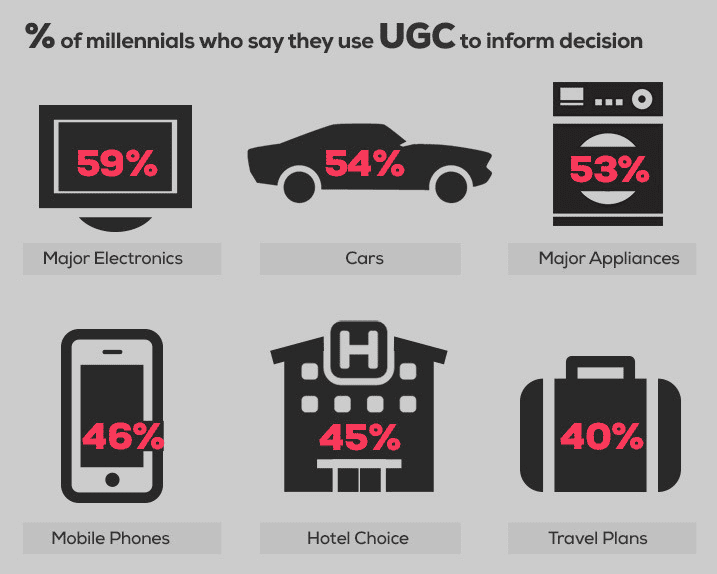
Source
61. About 13% of Gen Z shoppers who buy something directly from social media say UGC was the biggest influence on their decision. This is less than influencer recommendations (32%) and exclusive discounts (26%), but more than live shopping events (11%).
62. More than half (55%) of Gen Zers aged 18-29 want to be featured on a brand’s social media pages.
63. A huge 80% of Gen Z consumers aged 18-29 have either shared or are willing to share their purchases on social media.
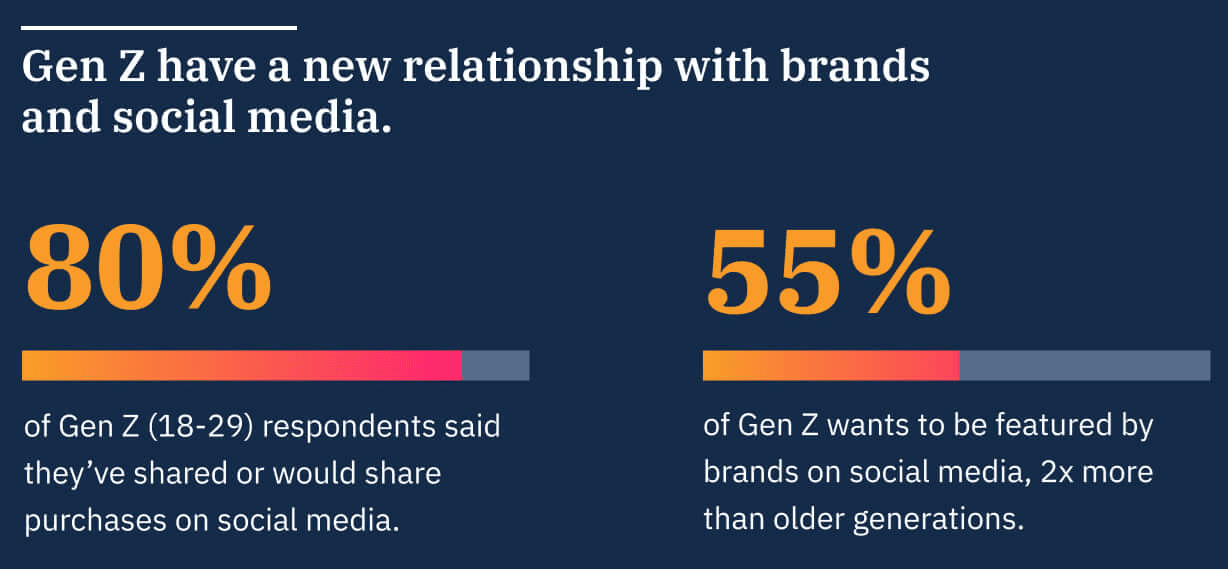
Source
UGC in Advertising Campaigns
A strong UGC strategy involves using user-generated content in your ads. Here are some stats that show how ads based on UGC stack up against traditional ads and why they are important for brands:
64. Ads that use UGC have 4 times higher click-through rates and 50% lower cost-per-click compared to average ads.
65. Ads featuring UGC see a 50% drop in cost-per-click compared to those without it.
66. UGC ads receive 73% more positive comments on social media than traditional ads.
67. 31% of consumers say ads with UGC are more memorable than standard ads.
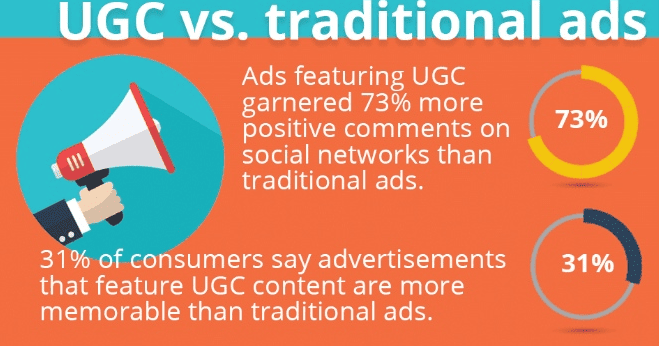
Source
68. 86% of brands believe that using UGC in their paid and owned media will make their ads and content more effective.
69. According to Crowdriff’s report on hospitality marketing, only 25% of resort and hotel ads are using UGC. Surprisingly, 77% still depend on professional content for their Meta ads, and 71% of resorts and hotels don’t have any UGC galleries on their websites.
70. By 2030, it’s predicted that 30% of all ads will be based on UGC, mixing content and advertisements.
71. UGC is increasingly important in influencing buying decisions. About 22% of consumers are more likely to buy products after seeing ads with shopper reviews. Additionally, 18% are influenced by ads that show shopper photos, while 13% respond to branded videos featuring UGC.
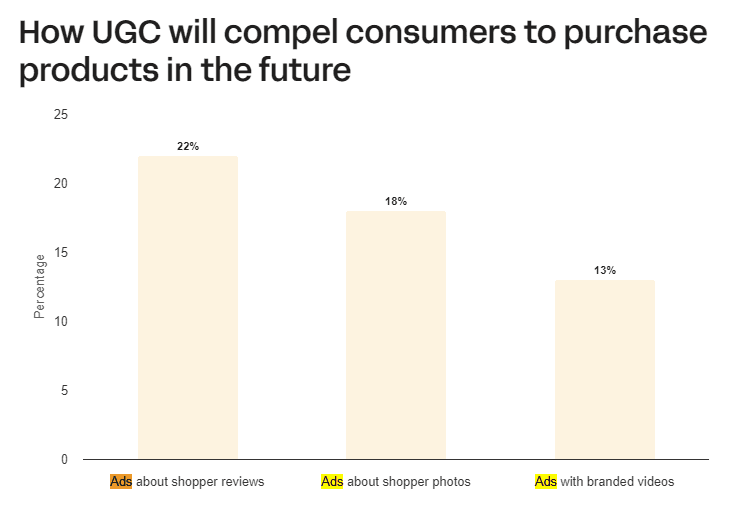
Source
UGC in Reviews and Online Presence
Customer content isn’t just a great strategy for your social media marketing—it also has a valuable benefit that often gets overlooked.
User-generated content can enhance your search engine optimization goals, making your website easier to find on search engines.
Here are some user-generated content stats that show how customer reviews can benefit businesses and how UGC improves online visibility.
72. Almost half (44%) of B2B buyers believe that peer reviews and user-generated content are increasingly important in their purchasing decisions.
73. The percentage of consumers who ‘always’ or ‘regularly’ read online reviews has stayed steady over the last three years, with 75% in 2024 compared to 76% in 2023. Only 3% of consumers say they ‘never’ read online reviews, showing how essential they are in people’s research.
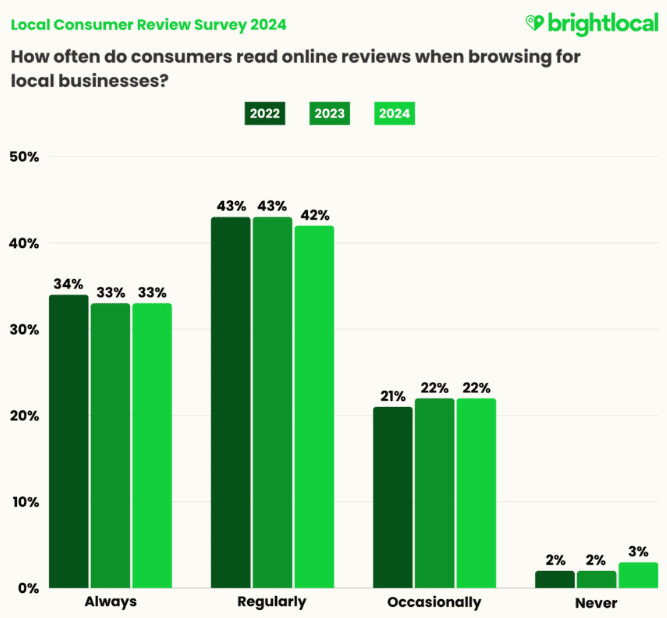
Source
74. User-generated reviews can improve product page SEO rankings by up to 25%.
75. Bazaarvoice clients experience 3 times more conversions when they combine social content with ratings and reviews in retail.
76. 63% of companies depend on ratings and reviews to help them reach their SEO goals.
77. Just 10 product reviews can increase the conversion rate by 45%.
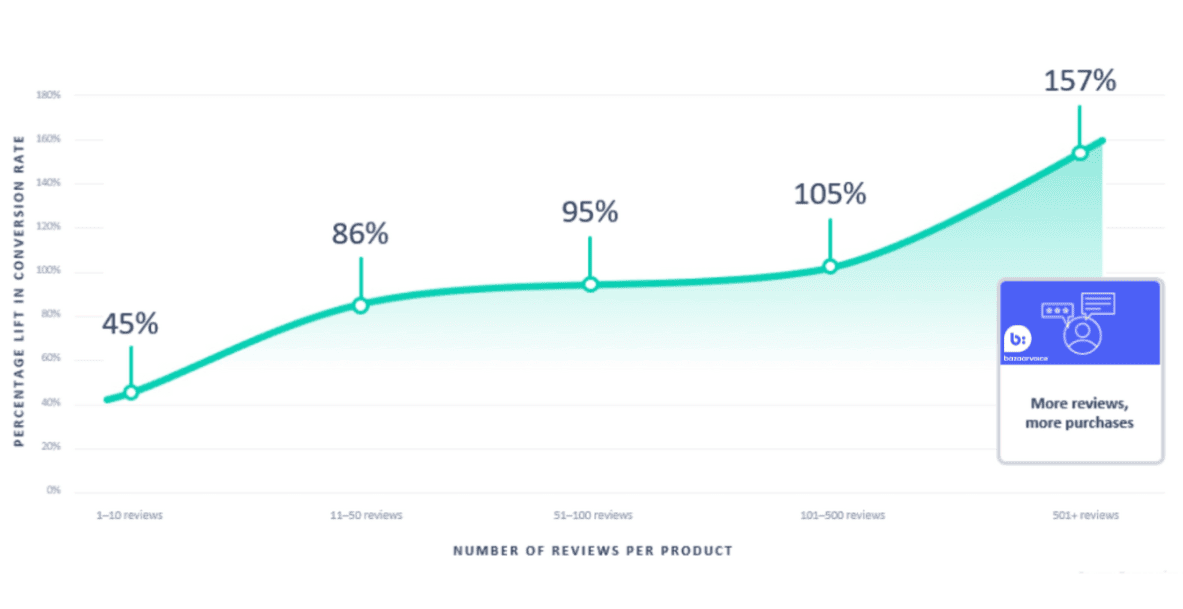
Source
78. 56% of internet users discover products through friends or acquaintances, while 32% rely on customer reviews.
79. 70% of shoppers prefer to buy a more expensive product with higher ratings and reviews rather than a cheaper product with fewer reviews.
80. 61% of consumers agree that recent reviews (written within the last three months) are more trustworthy than older reviews.
81. Google is still the most popular site for reading online reviews, but the percentage of consumers using it for this purpose has dropped from 87% in 2023 to 81% in 2024.
82. According to Keywords Everywhere, the search volume for “Google reviews” is 673,000 searches per month, and this number has remained steady (slightly increasing) over the past year, indicating that customers are looking for reviews before making purchases.

Conclusion
After reading the user-generated content stats above and doing your own research, you hopefully realize how impactful UGC can be.
It’s cost-effective, drives long-term ROI, and helps your company reach more people authentically beyond your official marketing efforts.
While many organizations enjoy the content created by their audiences, they often lack a formal strategy in place.
Like any strategy your business pursues, setting goals will help you build that strategy and keep everyone focused on what needs to be done.


